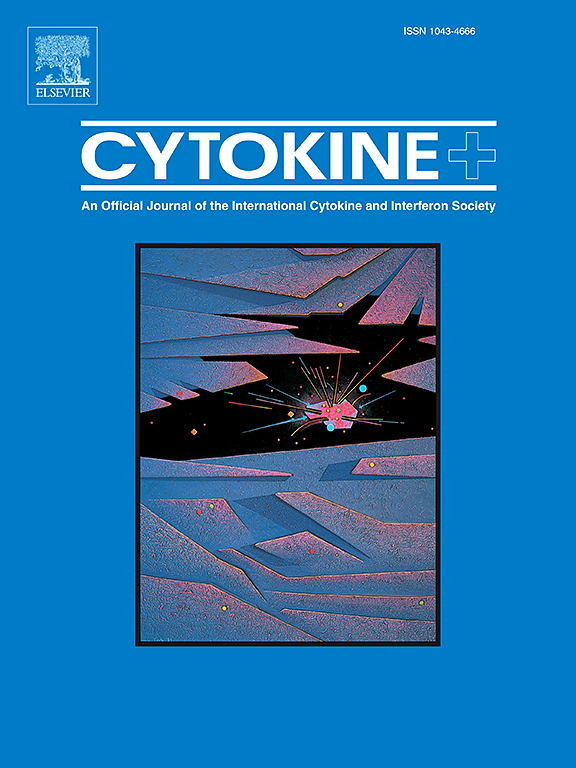肯尼亚Moi教学和转诊医院不同疾病严重程度患者的细胞因子免疫特征
IF 3.7
3区 医学
Q2 BIOCHEMISTRY & MOLECULAR BIOLOGY
引用次数: 0
摘要
背景:COVID-19的严重程度多种多样,从无症状到病情危重。严重急性呼吸系统综合征冠状病毒 2(SARS-CoV-2)阳性患者的免疫图谱可作为疾病严重程度的早期指标,帮助确定患者护理的优先次序:从分子实验室生物储存库中提取存档病人血浆样本,确保男性、女性和不同疾病严重程度的病人具有同等代表性。社会人口学和疾病严重程度数据来自患者健康记录。使用 BD FACSCalibur 流式细胞仪测量促炎细胞因子(γ 干扰素 [IFN-γ]、肿瘤坏死因子-α [TNF-α]、白细胞介素-2 [IL-2] 和白细胞介素-17 [IL-17])和抗炎细胞因子(白细胞介素-4 [IL-4]、白细胞介素-6 [IL-6] 和白细胞介素-10 [IL-10])的水平。数据分析包括比较不同疾病严重程度的细胞因子水平,人口统计学数据以均数±标准差(SD)表示。统计显著性设定为P≤0.05:男性和女性的平均年龄分别为 49.6 ± 22.7 岁和 48.4 ± 23.7 岁。疾病严重程度类别的平均年龄为(33 ± 19)(无症状)、(45.2 ± 21.5)(中度)、(56.8 ± 18.7)(重度)和(61.95 ± 22)(危重)。25%的患者患有合并症,其中心血管疾病(41%)和肺部疾病(31%)最为常见。危重病人的主要症状包括呼吸困难(63%)和肌痛(60%),而鼻出血(46.2%)和胸痛(45.7%)在重症病例中很常见。胃肠道症状仅在重症组和危重组中出现。促炎细胞因子(IFN-γ、TNF-α 和 IL-17)的水平随病情严重程度呈线性增长。在抗炎细胞因子中,IL-6 和 IL-10 的水平也随着病情严重程度的增加而显著上升:结论:TNF-α、IL-17 和 IL-6 的水平与疾病严重程度相关,可作为预后生物标志物。高龄和潜在的合并症与疾病严重程度较高密切相关。本文章由计算机程序翻译,如有差异,请以英文原文为准。
Cytokine immune profiles among COVID 19 patients with different disease severities seeking treatment at Moi teaching and referral hospital, Kenya
Background
COVID-19 manifests with a wide range of severities, from asymptomatic to critical conditions. Immunological profiles in patients positive for severe acute respiratory syndrome coronavirus 2 (SARS-CoV-2) may serve as early indicators of disease severity, aiding in prioritizing patient care.
Methodology
Archived patient plasma samples were retrieved from the Molecular Lab Bio-repository, ensuring equal representation of males, females, and various disease severities. Socio-demographic and disease severity data were obtained from patient health records. Levels of pro-inflammatory cytokines (interferon-gamma [IFN-γ], tumor necrosis factor-alpha [TNF-α], interleukin-2 [IL-2], and interleukin-17 [IL-17]) and anti-inflammatory cytokines (interleukin-4 [IL-4], interleukin-6 [IL-6], and interleukin-10 [IL-10]) were measured using the BD FACSCalibur flow cytometer. Data analysis involved comparing cytokine levels across different disease severities, with demographic data expressed as means ± standard deviation (SD). Statistical significance was set at P ≤ 0.05.
Findings
The mean ages for males and females were 49.6 ± 22.7 and 48.4 ± 23.7, respectively. Mean ages for disease severity categories were 33 ± 19 (asymptomatic), 45.2 ± 21.5 (moderate), 56.8 ± 18.7 (severe), and 61.95 ± 22 (critical). Comorbidities were present in 25 % of patients, with cardiovascular disease (41 %) and pulmonary disease (31 %) being the most common. Predominant symptoms in critical patients included dyspnea (63 %) and myalgia (60 %), while rhinorrhea (46.2 %) and chest pain (45.7 %) were common in severe cases. Gastrointestinal symptoms were observed only in severe and critical groups. Levels of the pro-inflammatory cytokines (IFN-γ, TNF-α, and IL-17) increased linearly with disease severity. Among anti-inflammatory cytokines, IL-6 and IL-10 levels also rose significantly with increasing severity.
Conclusion
Levels of TNF-α, IL-17, and IL-6 correlated with disease severity and may serve as prognostic biomarkers. Advanced age and underlying comorbidities were independently associated with higher disease severity.
求助全文
通过发布文献求助,成功后即可免费获取论文全文。
去求助
来源期刊

Cytokine
医学-免疫学
CiteScore
7.60
自引率
2.60%
发文量
262
审稿时长
48 days
期刊介绍:
The journal Cytokine has an open access mirror journal Cytokine: X, sharing the same aims and scope, editorial team, submission system and rigorous peer review.
* Devoted exclusively to the study of the molecular biology, genetics, biochemistry, immunology, genome-wide association studies, pathobiology, diagnostic and clinical applications of all known interleukins, hematopoietic factors, growth factors, cytotoxins, interferons, new cytokines, and chemokines, Cytokine provides comprehensive coverage of cytokines and their mechanisms of actions, 12 times a year by publishing original high quality refereed scientific papers from prominent investigators in both the academic and industrial sectors.
We will publish 3 major types of manuscripts:
1) Original manuscripts describing research results.
2) Basic and clinical reviews describing cytokine actions and regulation.
3) Short commentaries/perspectives on recently published aspects of cytokines, pathogenesis and clinical results.
 求助内容:
求助内容: 应助结果提醒方式:
应助结果提醒方式:


